Climbing Rose Cardigan |
||||
 |
 |
|||
Knitted jacket in DROPS Melody. Piece is knitted bottom up with stockinette stitch and V-neck. Size XS – XXL.
DROPS 240-6 |
||||
|
---------------------------------------------------------- EXPLANATION FOR THE PATTERN: ---------------------------------------------------------- GARTER STITCH (back and forth): Knit all rows. 1 ridge vertically = knit 2 rows. BUTTONHOLES (bottom up): Decrease for buttonholes on right band, starting from the right side as follows: Knit sixth and seventh stitch from edge together and make 1 yarn over. On next row from the wrong side, purl yarn over to make hole. Decrease for buttonholes when piece measures: XS: 8, 16 and 24 cm = 3⅛", 6¼" and 9½" S: 8, 16 and 25 cm = 3⅛", 6¼" and 9¾" M: 8, 17 and 26 cm = 3⅛", 6¾" and 10¼" L: 7, 14, 21 and 28 cm = 2¾", 5½", 8¼" and 11" XL: 7, 14, 21 and 28 cm = 2¾", 5½", 8¼" and 11" XXL: 7, 15, 23 and 30 cm = 2¾", 6", 9" and 11¾" DECREASE TIP (applies to V-neck): All decreases are done from the right side. RIGHT FRONT PIECE: Work 13 band stitches, knit 1, slip 1 stitch knitwise, knit 1, and pass slipped stitch over stitch worked. LEFT FRONT PIECE: Work until 16 stitches remain, knit 2 together, knit 1 and work 13 band stitches as before. DECREASE TIP-2 (applies to mid under sleeves): Decrease 1 stitch on each side of marker thread as follows: Work until 3 stitches remain before marker thread and knit 2 together, knit 2 (marker thread is between these 2 stitches), slip 1 stitch knitwise, knit 1, pass slipped stitch over stitch worked. ------------------------------------------------------- START THE PIECE HERE: ------------------------------------------------------- JACKET - SHORT OVERVIEW OF THE PIECE: Worked back and forth, bottom up and sewn together when finished. Pick up stitches around each armhole. First work the sleeves back and forth on circular needle and then in the round on double pointed needles / short circular needle. BACK PIECE: Cast on 80-88-92-100-108-120 stitches on circular needle size 5 MM = US 8 with DROPS Melody. Purl 1 row from wrong side. Then work back and forth in rib as follows: 1 stitch in GARTER STITCH - read explanation above, * purl 2, knit 2 *, repeat from *-* until 3 stitches remain, purl 2 and 1 stitch in garter stitch. Continue like this until rib measures 8 cm = 3⅛". Switch to circular needle size 6 MM = US 10. Knit 1 row from right side while decreasing 12-14-14-16-18-22 stitches evenly = 68-74-78-84-90-98 stitches. Then work in stockinette stitch with 1 stitch in garter stitch in each side. REMEMBER THE KNITTING GAUGE! When piece measures 32-33-34-35-36-37 cm = 12½"-13"-13⅜"-13¾"-14¼"-14½", bind off 2-3-4-6-7-9 stitches for armholes at the beginning of the next 2 rows = 64-68-70-72-76-80 stitches. Continue in stockinette stitch. When piece measures 47-49-51-53-55-57 cm = 18½"-19¼"-20"-21"-21⅝"-22½", bind off the middle 12-14-14-16-16-16 stitches for neck and finish each shoulder separately. Continue as before and bind off stitches for neck at the beginning of every row from neck as follows: Bind off 2 stitches 1 time and 1 stitch 2 times = 22-23-24-24-26-28 stitches remain on shoulder. Work until piece measures 50-52-54-56-58-60 cm = 19¾"-20½"-21¼"-22"-22¾"-23⅝". Bind off knitting from right side. Work the other shoulder the same way. RIGHT FRONT PIECE: Cast on 52-56-60-64-68-72 stitches on circular needle size 5 MM = US 8 with DROPS Melody. Purl 1 row from wrong side. Then work rib as follows from right side and mid front: 1 stitch in garter stitch, * knit 2, purl 2 *, work from *-* until 3 stitches remain, knit 2 and 1 stitch in garter stitch. Continue like this until rib measures 8 cm = 3⅛", AT THE SAME TIME decrease for BUTTONHOLES - see explanation above. Switch to circular needle size 6 MM = US 10. Then work as follows from right side: 1 stitch in garter stitch, (knit 2, purl 2) over the next 12 stitches, knit the next 38-42-46-50-54-58 stitches while AT THE SAME TIME decreasing 5-6-8-9-10-10 stitches evenly over these stitches, 1 stitch in garter stitch = 47-50-52-55-58-62 stitches. Continue with 1 stitch in garter stitch, (knit 2/purl 2) over the 12 band stitches, stockinette stitch and 1 stitch in garter stitch in the side - remember BUTTONHOLES. When piece measures 26-27-28-29-30-31 cm = 10¼"-10⅝"-11"-11⅜"-11¾"-12¼" begin decrease for V-neck. AT THE SAME TIME as decrease for V-neck, bind off for armholes, read the following section before continuing. V-NECK: Decrease for V-neck every 2 cm = ¾" 10-11-11-12-12-12 times in total - read DECREASE TIP. ARMHOLES: At the same time when piece measures 32-33-34-35-36-37 cm = 12½"-13"-13⅜"-13¾"-14¼"-14½", bind off 2-3-4-6-7-9 stitches for armhole at the beginning of next row from wrong side. After all decreases for V-neck and armhole, 35-36-37-37-39-41 stitches remain on needle. Continue with band stitches and stockinette stitch with 1 stitch in garter stitch towards the side until piece measures 50-52-54-56-58-60 cm = 19¾"-20½"-21¼"-22"-22¾"-23⅝". On next row from wrong side bind off the first 22-23-24-24-26-28 stitches for shoulder and work over band as before for approx. 8-9-9-10-10-10 cm = 3⅛"-3½"-3½"-4"-4"-4". Bind off. LEFT FRONT PIECE: Cast on 52-56-60-64-68-72 stitches on circular needle size 5 MM = US 8 with DROPS Melody. Purl 1 row from wrong side. Then work rib as follows from right side and the side: 1 stitch in garter stitch, * knit 2, purl 2 *, work from *-* until 3 stitches remain, knit 2 and 1 stitch in garter stitch. Continue like this until rib measures 8 cm = 3⅛". Switch to circular needle size 6 MM = US 10. Then work as follows from right side: 1 stitch in garter stitch, knit the next 38-42-46-50-54-58 stitches while AT THE SAME TIME decreasing 5-6-8-9-10-10 stitches evenly over these stitches, work (purl 2/knit 2) over the next 12 stitches, 1 stitch in garter stitch = 47-50-52-55-58-62 stitches. Continue with 1 stitch in garter stitch, stockinette stitch and (knit 2/purl 2) over the 12 band stitches, and 1 stitch in garter stitch. When piece measures 26-27-28-29-30-31 cm = 10¼"-10⅝"-11"-11⅜"-11¾"-12¼" begin decrease for V-neck. AT THE SAME TIME as decrease for V-neck, bind off for armholes, read the following section before continuing. V-NECK: Decrease for V-neck every 2 cm = ¾" 10-11-11-12-12-12 times in total - read DECREASE TIP. ARMHOLES: At the same time when piece measures 32-33-34-35-36-37 cm = 12½"-13"-13⅜"-13¾"-14¼"-14½", bind off 2-3-4-6-7-9 stitches for armhole at the beginning of next row from right side. After all decreases for V-neck and armhole, 35-36-37-37-39-41 stitches remain on needle. Continue with band stitches and stockinette stitch with 1 stitch in garter stitch towards the side until piece measures 50-52-54-56-58-60 cm = 19¾"-20½"-21¼"-22"-22¾"-23⅝". On next row from right side bind off the first 22-23-24-24-26-28 stitches for shoulder and work over band as before for approx. 8-9-9-10-10-10 cm = 3⅛"-3½"-3½"-4"-4"-4". Bind off. ASSEMBLY: Sew shoulder seams to get a flat and nice seam. SLEEVES: Use circular needle size 6 MM = US 10 and DROPS Melody. Pick up from right side 50-53-56-59-62-64 stitches - begin from the bottom of armhole. Insert 1 marker in the middle of row – measure sleeve from this marker. Work in stockinette stitch back and forth until sleeve measures 1-1-2-4-5-6 cm = ⅜"-⅜"-¾"-1½"-2"-2⅜" from marker. Now put piece together on a short circular needle or double pointed needles size 6 MM = US 10 - work the rest of sleeve in the round. Insert 1 marker thread at the beginning of round (mid under sleeve). Move marker thread upwards when working. Begin round at the marker thread and work in stockinette stitch. When sleeve measures 4-3-3-1-1-1 cm = 1½"-1⅛"-1⅛"-⅜"-⅜"-⅜", decrease 2 stitches mid under sleeve - read DECREASE TIP. Decrease like this every 5-4½-4½-4-3½-3½ cm = 2"-1⅝"-1⅝"-1½"-1¼"-1¼" 7-8-8-9-10-10 times in total = 36-37-40-41-42-44 stitches. Work until sleeve measures 43 cm = 17" from marker. Knit 1 round while increasing 12-11-12-11-14-12 stitches evenly = 48-48-52-52-56-56 stitches. Switch to double pointed needles size 5 MM = US 8. Work rib (knit 2/purl 2) for 8 cm = 3⅛". Bind off. Sleeve measures approx. 51 cm = 20" from marker. Work the other sleeve the same way. ASSEMBLY: Sew bottom of armholes - see chart. Sew side seams inside 1 edge stitch. Sew band together mid back and sew on to neckline at the back of neck. Sew the buttons onto the left front piece. |
||||
Diagram explanations |
||||
|
||||
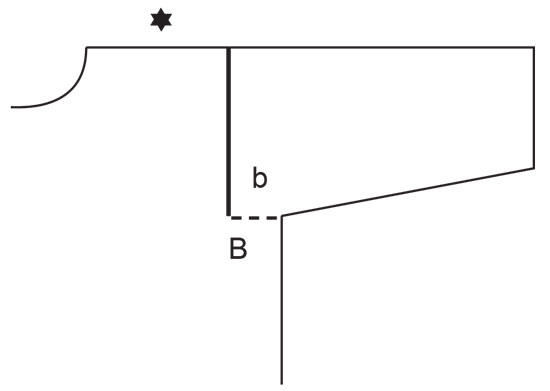
|
||||
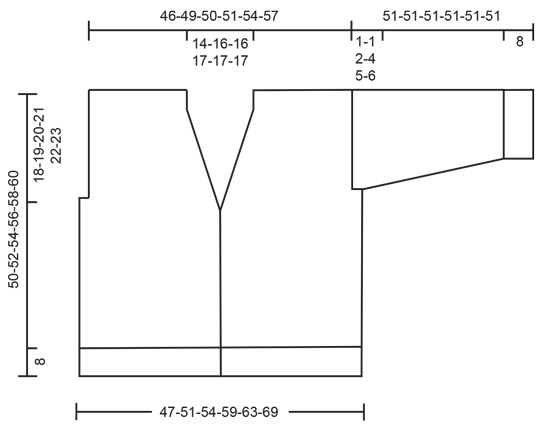
|
||||
|
Have you made this or any other of our designs? Tag your pictures in social media with #dropsdesign so we can see them! Do you need help with this pattern?You'll find tutorial videos, a Comments/Questions area and more by visiting the pattern on garnstudio.com. © 1982-2024 DROPS Design A/S. We reserve all rights. This document, including all its sub-sections, has copyrights. Read more about what you can do with our patterns at the bottom of each pattern on our site. |
||||










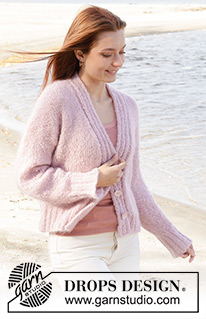






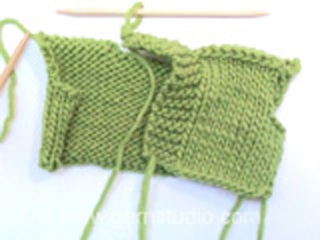



























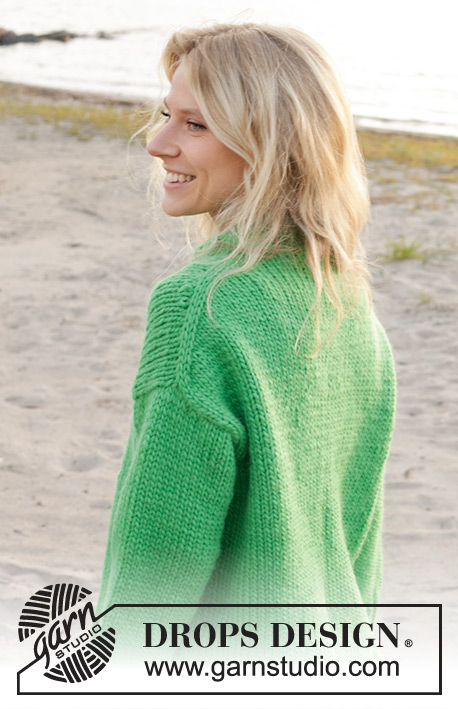









Comments / Questions (20)
Beste, de panden worden van onder naar boven gebreid en de mouwen van boven naar onder? Dit geeft toch een ander beeld van het stekenpatroon ? Is dit de bedoeling ?Veerle
17.04.2024 - 14:45DROPS Design answered:
Dag Veerle,
Nee hoor, je kunt gewoon tricotsteek van boven naar onder breien, dat ziet er hetzelfde uit als wanneer je tricotsteek van onder naar boven breit.
17.04.2024 - 21:49Beste, de panden worden van onder naar boven gebreid en de mouwen van boven naar onder? Dit geeft toch een ander beeld van het stekenpatroon ? Is dit de bedoeling ?\r\nVeerle
31.03.2024 - 16:50DROPS Design answered: Hej, Du strikker masker op der fra hvor du lukkede masker af til ærmegab og strikker frem og tilbage de første 1-1-2-4-5-6 cm (alt efter hvilken størrelse du strikker) :) spørgsmål: Vil det så sige at de 6 masker jeg lukkede af til ærmegab skal være med i de masker jeg strikker op❓(undskyld at jeg åbenbart både skal have det skåret ud i pap og ind med skeer)
16.01.2024 - 15:47DROPS Design answered:
Hej Kitter, nej, de 6 masker du lukkede af til ærmegab, skal du ikke strikke op i, dem syr du de første cm af ærmet fast i bagefter :)
17.01.2024 - 13:12Når jeg tager masker op til ærmer, skal jeg så tage op helt ude fra aflukningen til ærmegab, eller skal det være indenfor❓
15.01.2024 - 14:31DROPS Design answered:
Hej, Du strikker masker op der fra hvor du lukkede masker af til ærmegab og strikker frem og tilbage de første 1-1-2-4-5-6 cm (alt efter hvilken størrelse du strikker) :)
16.01.2024 - 14:27How do i convert patern from circular knitting needles to straight one's
02.09.2023 - 08:43DROPS Design answered:
Dear Marjorie, you can read here how to adapt a pattern for straight needles: https://www.garnstudio.com/lesson.php?id=13&cid=19. Happy knitting!
03.09.2023 - 20:15On the climbing rose cardigan, I have started the sleeves, I am at the point of knitting in a round, but am not sure if i need to purl or knit, I am on the wrong side? can you please help?
08.07.2023 - 19:44DROPS Design answered:
Dear Catherine, after joining the sleeves you will be working in the round, which is usually the right side unless otherwise stated. Since you work in stocking stitch you will knit all rounds. Happy knitting!
10.07.2023 - 17:05I am sorry but I do not understand on the climbing rose cardigan, to knit the sleeves it says pick up 56 stitches from the right side from the bottom of the armhole, I have lots more stitches than that? could u explain what I need to do please?
28.06.2023 - 15:31DROPS Design answered:
Dear Mrs Randall, from the bottom of armhole through the seam until the bottom of armhole on the other side you should have 40 cm (size L), with a tension of 14 sts = 10 cm, you should have then 40 x 1,4 = 56 stitches along the armhole. In this video we show how to pick up stitches, it might help you. If you have some more stitches you can also decrease on first row (purling 2 stitches together evenly spaced). Happy knitting!
28.06.2023 - 16:29Bonjour, Dans le modèle DROPS 240-6 Climbing rose cardigan , vous mentionnez "1 côte mousse = tricoter 2 rangs endroit" Je ne comprends pas bien, est-ce que cela veut dire qu'il faut toujours commencer et terminer les rangs par une maille endroit ?? Merci pour votre réponse
07.05.2023 - 15:15DROPS Design answered:
Bonjour Mme Rivet, pour tricoter au point mousse, il faut tricoter à l'endroit tous les rangs; lorsque vous tricotez 1 maille lisière au point mousse, vous tricotez cette maille à l'endroit tous les rangs (sur l'endroit et sur l'envers). Dans cette vidéo, nous montrons comment tricoter 1 m lisière au point mousse de chaque côté. Bon tricot!
08.05.2023 - 08:12Je ne comprends pas pourquoi vous dites de coudre a contre A puisque les mailles des manches ont été relevées, normalement il n'y a pas de couture à cet endroit ? ? Ou alors je n'ai pas compris quelque chose ..? Merci d'avance de votre réponse
15.04.2023 - 14:13DROPS Design answered:
Bonjour Thérèse, vous avez raison, le schéma doit être changer ici, la partie A et a correspondent aux mailles relevées, vous n'avez que la partie B à assembler contre b (les 1-1-2-4-5-6 premiers cm de la manche tricotés en rangs). Bon tricot!
17.04.2023 - 08:58Sorry, foutje van mij, na mindering zijn het 55 steken 🙄
19.03.2023 - 16:42